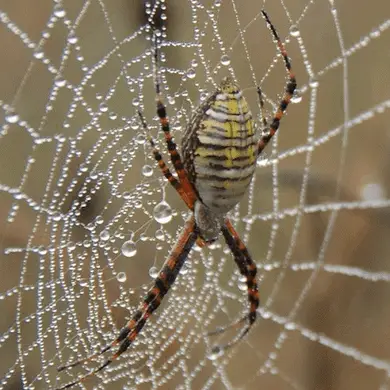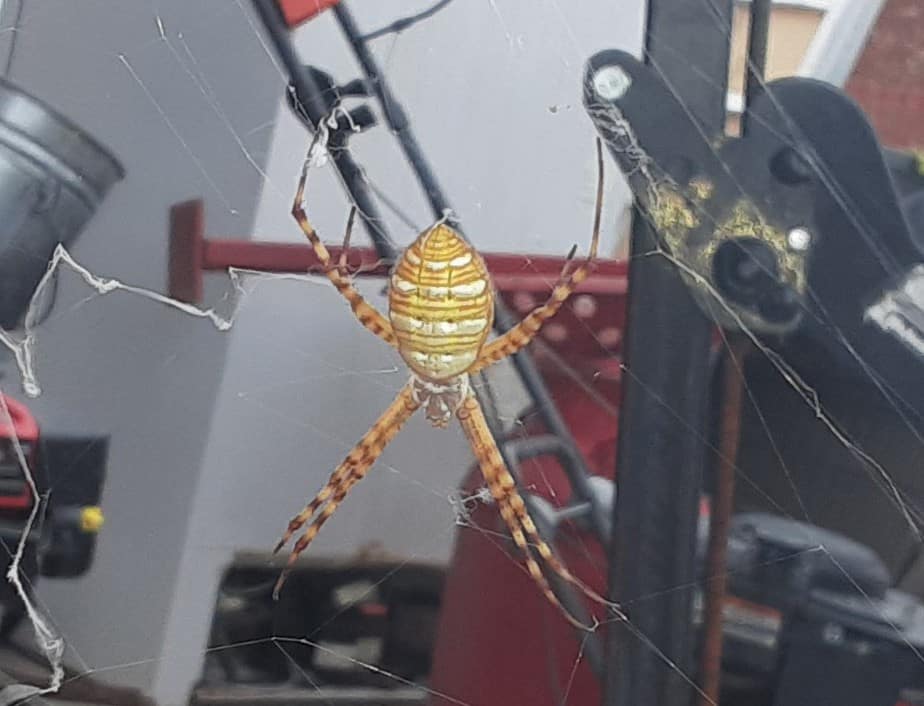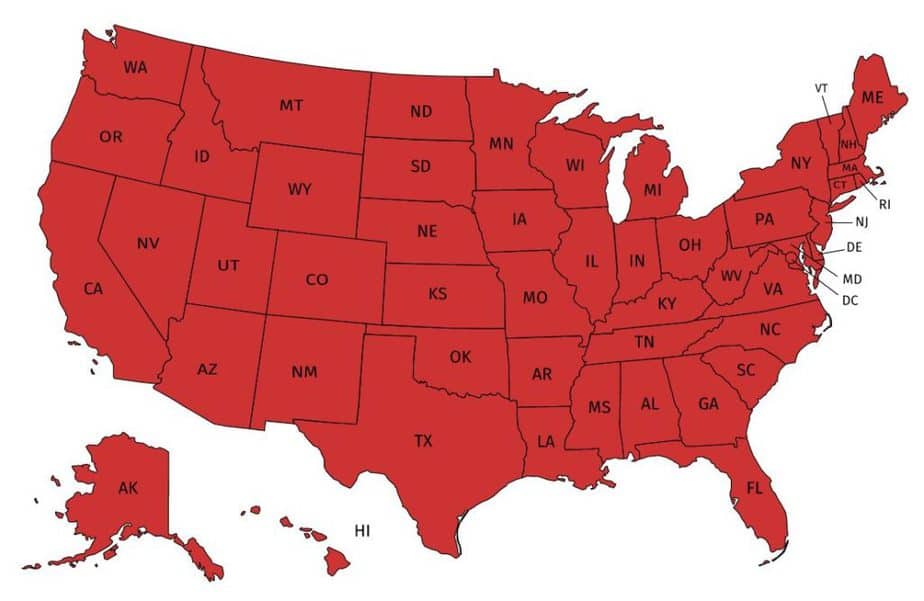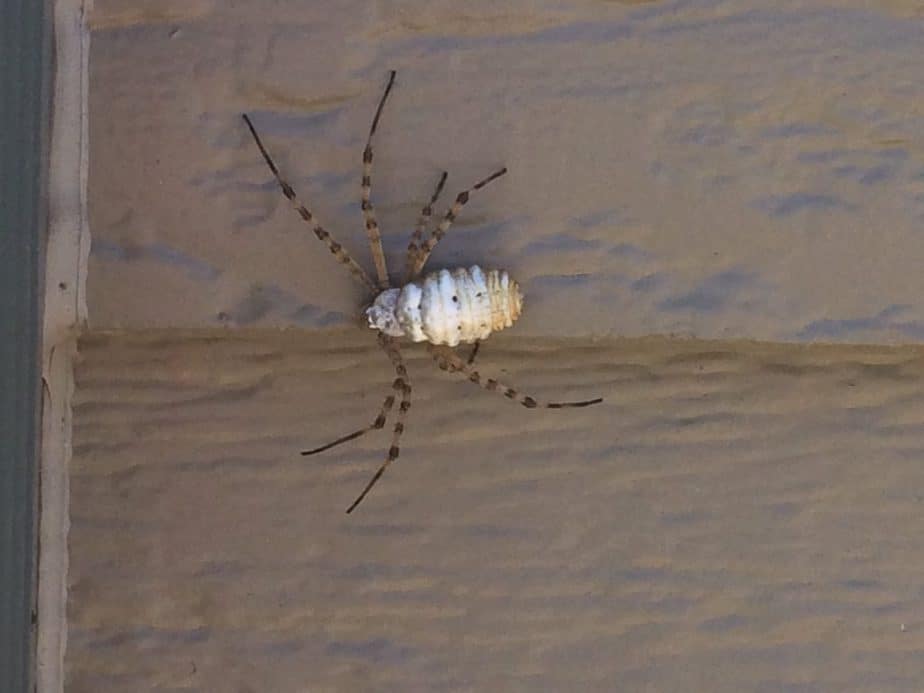The Argiope trifasciata or Banded Garden Spider is one of the most common species of the Argiope orb weaving spider. Originally, the spider originated in North America but can now be found all over the world.
The Banded Garden Spider appears in all US states. In some areas, this type of orb weaver is even considered a pest.
Argiope Trifasciata Description
The Argiope trifasciata looks very similar to the Argiope aurantia. However, their abdomen looks like it would be white, with thin, black and yellow bands covering it. The legs are deep orange with black bands on them.

The pattern for the Banded Argiope has multiple stripes running across the abdomen. Males have a much more nondescript abdomen and the entire spider has more of a shiny fuzzy brownish look to it.
Argiope Trifasciata Size
The body of the female Argiope trifasciata can grow up to one inch (25 mm). Like the Arigope aurantia, they can grow to a size of up to three inches including their legs.
Web of the Banded Garden Spider
The web usually reaches a diameter of around 2 feet (60 cm). Webs with a diameter of over 6 feet (2 m) have also been seen. The web of the Banded Garden Spider can usually be recognized on the beautifully created zigzag patterns stitching down the middle of the web where the spider rests.

Bite of the Argiope Trifasciata
While the spider uses poison to kill smaller insects, the bite of the Argiope trifasciata is not dangerous to humans. It is often compared to the pain level of a bee sting and might lead to swelling and minor pain.
Argiope Aurantia Scientific Classification
- Kingdom: Animalia
- Phylum: Arthropoda
- Subphylum: Chelicerata
- Class: Arachnida
- Order: Araneae
- Infraorder: Araneomorphae
- Family: Aranidae
- Genus: Argiope
- Species: Argiope Trifasciata
Other common names
Banded orb weaving spider, banded garden spider, banded argiope, banded orb weaver
Distribution of the banded garden spider in the USA

The banded garden spider can be found in every US state – Alabama, Alaska, Arizona, Arkansas, California, Colorado, Connecticut, Delaware, Florida, Georgia, Hawaii, Idaho, Illinois, Indiana, Iowa, Kansas, Kentucky, Louisiana, Maine, Maryland, Massachusetts, Michigan, Minnesota, Mississippi, Missouri, Montana, Nebraska, Nevada, New Hampshire, New Jersey, New Mexico, New York, North Carolina, North Dakota, Ohio, Oklahoma, Oregon, Pennsylvania, Rhode Island, South Carolina, South Dakota, Tennessee, Texas, Utah, Vermont, Virginia, Washington, West Virginia, Wisconsin, Wyoming



I found this spider in an old tire in my back yard and could t find out what kind it was it has eggs also
Hello Carter,
Thanks for getting in touch. Unless you live outside the United States, this is a banded garden spider (Argiope trifasciata). Its abdomen seems somewhat shrunk and deformed which happens sometimes after it has laid eggs. It’s not a medically significant spider and great to have around for insect control. You can read more about it here: http://usaspiders.com/arigope-trifasciata-banded-garden-spider/
Saw this spider on my porch today. I believe it is an Argiope trifasciata. the underside has 2 stripes on a black body, and the top side had very interesting coloring. sending u copy as you might enjoy them. in some of the pics the zig zag web is very visable.
2nd pic, underside, yellow stripes
Is this spider poisonous
This is a Argiope Trifasciata spider, also known as a Banded Garden Spider
The spider does have venom but it is not poisonous to humans, the bite is similar to a bee or wasp sting. They are a very calm spider unless aggravated.
Top and bottom view of spider is posted.
additional pic
I have watching two large orb like webs with a large brown spider in the center for the past month or two. Two days ago, both disappeared not to be seen again. Do you know where they went and what they did? I imagine this is the final phase of their life cycle but the sources I have read do not explain this. I miss them, having purposely avoided their webs the whole time. I look forward to your conclusion. I live in Kent, WA. Thank you very much. Peter Nikaitani
Living in planter at bingo in Fargo ND
Had a grasshopper all wrapped up in his web!
Hello Kristin, thanks for getting in touch. This is a banded garden spider (Argiope trifasciata): https://usaspiders.com/argiope-trifasciata-banded-garden-spider/
It’s not a medically significant spider and great to have around for pest control purposes.
Rapid city south dakota. Chilling in our front yard … almost burned it down, but uploaded instead
Help…
Hi Kelsey, I think it’s a great decision you decided not to burn it down 🙂 this spider is harmless and will get rid of annoying flying insects for you. It’s a banded garden spider (Argiope trifasciata): https://usaspiders.com/argiope-trifasciata-banded-garden-spider/
These guys are outside and pervasive. They appear to be some kind of banded garden spider but I don’t see a pictorial match. In the larger webs, there are two spiders, one larger, in close proximity. Although considered untidy by some, I prefer to leave them for pest control. Cumming, Georgia
That’s definitely not a banded garden spider
Found this in western ND, I’ve never seen one before, is this the garden spider I’m reading about? Thought maybe I was lucky and found a St. Andrew Cross Spider! Haha
This spider has been hanging around my back door in South Dakota for the past few days. I will probably just leave it there.
Spider found in a web outside next to a window. South-eastern Idaho. Seemed relatively calm around me, it let me get up close for this photo
Hello Kevin, thanks for getting in touch and for sharing this great shot! This is a male Argiope garden spider. Most likely Argiope trifasciata. They are significantly smaller than the females: https://usaspiders.com/argiope-trifasciata-banded-garden-spider/
Hi I found this spider attempting to climb my bedroom wall it seemed to keep slipping. The color and shape of the body are making me really nervous! Found in south eastern ohio I shined a light on it after I caught it in a container and they’re tan, uniform in color. I can’t tell the layout of the eyes. I thought it looked like a crevice spider but the pedipalp (?) aren’t connected! My husband got bit on the top of the foot by a spider last night so I’m assuming this could be the culprit. Thanks in advance
Hello Shala, this spider is nothing to get nervous about. It’s a male banded garden spider (Argiope trifasciata): https://usaspiders.com/argiope-trifasciata-banded-garden-spider/
It’s very unlikely that this was the spider that bit your husband (but not impossible).
Found this guy in my backyard in Carson City, NV would like to know if it is venomous and what kind
Thank you
Eduardo
Hello Eduardo, thanks for getting in touch! This is a banded garden spider (Argiope trifasciata): https://usaspiders.com/argiope-trifasciata-banded-garden-spider/
It’s not medically significant spider.
I reside in the South Okanagan region of British Columbia, within 60 km of the US border. a few days ago this spider was seen in the yard. It might be a Banded garden Spider but I cannot confirm this. I’ve attached two photos.
Indianapolis, IN
Found this in the upper corner of the outside porch. Body is probably just larger than a quarter. It is hanging in a rather tangled web. Curious what I have here!
Hello Austin, this is a banded garden spider (Argiope trifasciata): https://usaspiders.com/argiope-trifasciata-banded-garden-spider/
It’s a garden orbweaver that will catch flying pests free of charge 🙂 It’s not medically significant for humans or pets.
hello! Are banded garden spider dangerous for cats and dogs?
Found in my yard, southern Maine
Hello Matt, thanks for getting in touch! This is a banded garden spider (Argiope trifasciata): https://usaspiders.com/argiope-trifasciata-banded-garden-spider/
I found this spider on my porch. Can you identify it for me please?
Hello Lorraine, thanks for getting in touch! Unfortunately, I can’t really tell the species off this picture alone as the abdomen is not clearly visible. It’s a type of male orbweaver, possibly Neoscona or Araneus species.
Found this one in Southern Nevada today. Not heavy on the stripes, but…
While working at Waterville Valley Ski area in central New Hampshire, I found this spider on a lift shack at 3500ft elevation. I estimate the body was the size of a quarter. Please help me identify this. Thanks
Hello Leighton, thanks for getting in touch! This is a banded garden spider (Argiope trifasciata): https://usaspiders.com/argiope-trifasciata-banded-garden-spider/
They are not medically significant.
Hi
My garden spider is long gone but she left an egg nest it’s on the concrete building at work it’s not out of the elements or sheltered at all I’m wondering if I should attempt to relocate it?
Here is the picture of the egg sack on the building at work. Should I try to relocate it somewhere safer? I posted earlier but picture didn’t show up
Hello Krissy, this egg sac looks unusually flat for a banded garden spider. It’s usually safe to relocate them. You can use a broom and place it in some bushes off the ground.
Thank You!
I’ll let you know what happens!
Krissy
Found this spider outside next to my plants. Not sure what kind it is. My dad found it and swears he’s going to keep it. Can anyone identify it? It’s fairly large and it’s back has brown lines all around. Pretty funky looking
Hello Izzy, thanks for getting in touch! This is a female banded garden spider (Argiope trifasciata): https://usaspiders.com/argiope-trifasciata-banded-garden-spider/
It’s not medically significant.
Grind found in Arizona yard.
What is it?
Hello William, thanks for getting in touch! This is a banded garden spider (Argiope trifasciata): https://usaspiders.com/argiope-trifasciata-banded-garden-spider/
Moorhead, MN
Found beside the back door of my house. I was struck by the markings which appear to be silver.
72A297A9-A3B0-4214-A423-AF87767369C6
Hi Dana, this is a banded garden spider (Argiope trifasciata): https://usaspiders.com/argiope-trifasciata-banded-garden-spider/
Hello! I sent an email, but thought I would share a comment of this as well. Over the past few days we noticed two of these spiders have attached themselves via the same web to our bbqer. The second is a little smaller than this one, but of the same species. There’s a beautiful one that has made a web above our door, but I am too short to get a good enough photo of that one. I live in Soap Lake, WA. Can anybody tell me what this is?
Hello Charlene, thanks for your comment! This is a juvenile banded garden spider (Argiope trifasciata): https://usaspiders.com/argiope-trifasciata-banded-garden-spider/
If you are interested in learning more about spiders in Washington State, check out our Washington spider identification and information book – available as an ebook here or as a printed paperback on Amazon
Hey folks, this mama was hanging on a few strands of webbing outside my kitchen door in Waverly, NY. About 1.5″ long including the legs. She had about a dozen pinhead-sized babies crawling around nearby.
I found this spider today suspended in thin air above my fountain grass in my garden-or so it appeared—at closer glance a web is there—can you tell me what this is? Burnsville Minnesota thanks!
Hi Melissa, this is a garden spider of the genus Argiope – most likely a banded garden spider: https://usaspiders.com/argiope-trifasciata-banded-garden-spider/
Found today in Orangeburg KY.
Hello Eddie, this is a banded garden spider (Argiope trifasciata):
https://usaspiders.com/argiope-trifasciata-banded-garden-spider/
Found this guy on the lower part of my door sill, beside my dishwasher. It’s been getting cooler up here as of late, so I expect spiders to make a more pronounced appearance, but I have never seen one like this before. Any Ideas? I am sorry if the photo is low quality, my phone was only 5% charged when I snapped the picture.
Leg span is around the size of american 50 cent piece.
Body is silvery in color and imitates metallic reflection in the right light.
Black and white banded legs.
Relatively slow movement, appears to have good eyesight. It spread two of its forelimbs low and wide above the ground when it noticed me.
The location is typically kept dark, as it is near the utility room and the back bathroom.
This was found in klamath falls, oregon at 10:30-ish at night
Hello Edward, this is a banded garden spider (Argiope trifasciata): https://usaspiders.com/argiope-trifasciata-banded-garden-spider/
Found in yard st pete. FL about a 9′ web